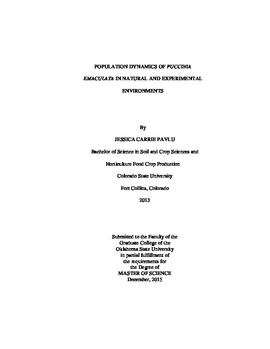| dc.contributor.advisor | Garzon, Carla D. | |
| dc.contributor.author | Pavlu, Jessica Carrie | |
| dc.date.accessioned | 2017-02-22T22:13:00Z | |
| dc.date.available | 2017-02-22T22:13:00Z | |
| dc.date.issued | 2015-12-01 | |
| dc.identifier.uri | https://hdl.handle.net/11244/49005 | |
| dc.description.abstract | Panicum virgutum L., commonly referred to as switchgrass, is a C4 grass native to most of North America. With its deep rooting system allowing for low nutrient and water requirements and high biomass production, switchgrass was selected by the U.S. Department of Energy (DOE) as a good crop for biofuel production. However, switchgrass has been reported to have substantial losses in biomass due to the fungal plant pathogen Puccinia emaculata also known as switchgrass rust. Thought to be a macrocyclic rust, switchgrass serves as P. emaculata's uredinial and telial host. In this study the population dynamics of P. emaculata was analyzed for the purpose of both epidemiological discovery and as a model for scientific attribution methods for rust. The first study used single spores across two states (Oklahoma and Virginia) and four years (2011, 2012, 2013, and 2014) to evaluate four previously described polymorphic microsatellite loci. The purpose of this study was to generate a conceptual analysis of population dynamics in a field setting over a series of years in two geographically distant states. Use of fixation indices showed low to moderate differentiation between states and moderate differentiation between years. All populations were discrete, with minute amounts of genotype migration between years. This result points to a similar inoculums source. The second study compared the field samples from the first study to growth chamber populations generated at Oklahoma State University over the same years to evaluate if the analysis method could provide scientific attribution. Similar origin populations with an unknown environment and to a completely unknown population were used to test the analysis method. The results showed the four microsatellite loci could be used to correlate populations of the same identity or reject the attribution of a population to the known population, but not to provide scientific attribution with the statistical support needed for a microbial forensic investigation. This study was unique in the use of single spores and a rust model for microbial forensic applications. With more microsatellite loci this method could be statistically sound enough for scientific attribution for a microbial forensic investigation. | |
| dc.format | application/pdf | |
| dc.language | en_US | |
| dc.rights | Copyright is held by the author who has granted the Oklahoma State University Library the non-exclusive right to share this material in its institutional repository. Contact Digital Library Services at lib-dls@okstate.edu or 405-744-9161 for the permission policy on the use, reproduction or distribution of this material. | |
| dc.title | Population Dynamics of Puccinia Emaculata in Natural and Experimental Environments | |
| dc.contributor.committeeMember | Fletcher, Jacqueline | |
| dc.contributor.committeeMember | Marek, Stephen M. | |
| osu.filename | Pavlu_okstate_0664M_14362.pdf | |
| osu.accesstype | Open Access | |
| dc.description.department | Entomology & Plant Pathology (MS) | |
| dc.type.genre | Thesis | |
| dc.type.material | text | |
